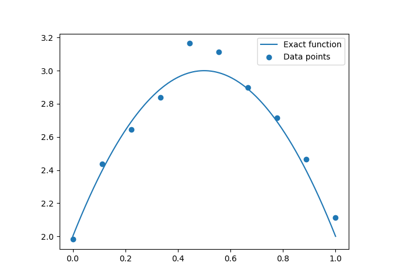polyreg module¶
Polynomial regression model.
Polynomial regression is a particular case of the linear regression, where the input data is transformed before the regression is applied. This transform consists of creating a matrix of monomials by raising the input data to different powers up to a certain degree \(D\). In the case where there is only one input variable, the input data \((x_i)_{i=1, \dots, n}\in\mathbb{R}^n\) is transformed into the Vandermonde matrix:
The output variable is expressed as a weighted sum of monomials:
where the coefficients \(w_1, w_2, ..., w_d\) and the intercept \(w_0\) are estimated by least square regression.
In the case of a multidimensional input, i.e. \(X = (x_{ij})_{i=1,\dots,n; j=1,\dots,m}\), where \(n\) is the number of samples and \(m\) is the number of input variables, the Vandermonde matrix is expressed through different combinations of monomials of degree \(d, (1 \leq d \leq D)\); e.g. for three variables \((x, y, z)\) and degree \(D=3\), the different terms are \(x\), \(y\), \(z\), \(x^2\), \(xy\), \(xz\), \(y^2\), \(yz\), \(z^2\), \(x^3\), \(x^2y\) etc. More generally, for \(m\) input variables, the total number of monomials of degree \(1 \leq d \leq D\) is given by \(P = \binom{m+D}{m} = \frac{(m+D)!}{m!D!}\). In the case of 3 input variables given above, the total number of monomial combinations of degree lesser than or equal to three is thus \(P = \binom{6}{3} = 20\). The linear regression has to identify the coefficients \(w_1, \dots, w_P\), in addition to the intercept \(w_0\).
Dependence¶
The polynomial regression model relies on the LinearRegression and PolynomialFeatures classes of the scikit-learn library.
- class gemseo.mlearning.regression.polyreg.PolynomialRegressor(data, degree, transformer=mappingproxy({}), input_names=None, output_names=None, fit_intercept=True, penalty_level=0.0, l2_penalty_ratio=1.0, **parameters)[source]¶
Bases:
LinearRegressorPolynomial regression model.
- Parameters:
data (IODataset) – The learning dataset.
degree (int) – The polynomial degree.
transformer (TransformerType) –
The strategies to transform the variables. The values are instances of
Transformerwhile the keys are the names of either the variables or the groups of variables, e.g."inputs"or"outputs"in the case of the regression algorithms. If a group is specified, theTransformerwill be applied to all the variables of this group. IfIDENTITY, do not transform the variables.By default it is set to {}.
input_names (Iterable[str] | None) – The names of the input variables. If
None, consider all the input variables of the learning dataset.output_names (Iterable[str] | None) – The names of the output variables. If
None, consider all the output variables of the learning dataset.fit_intercept (bool) –
Whether to fit the intercept.
By default it is set to True.
penalty_level (float) –
The penalty level greater or equal to 0. If 0, there is no penalty.
By default it is set to 0.0.
l2_penalty_ratio (float) –
The penalty ratio related to the l2 regularization. If 1, the penalty is the Ridge penalty. If 0, this is the Lasso penalty. Between 0 and 1, the penalty is the ElasticNet penalty.
By default it is set to 1.0.
**parameters (float | int | str | bool | None) – The parameters of the machine learning algorithm.
- Raises:
ValueError – If the degree is lower than one.
- class DataFormatters¶
Bases:
DataFormattersMachine learning regression model decorators.
- classmethod format_dict(predict)¶
Make an array-based function be called with a dictionary of NumPy arrays.
- Parameters:
predict (Callable[[ndarray], ndarray]) – The function to be called; it takes a NumPy array in input and returns a NumPy array.
- Returns:
A function making the function ‘predict’ work with either a NumPy data array or a dictionary of NumPy data arrays indexed by variables names. The evaluation will have the same type as the input data.
- Return type:
Callable[[ndarray | Mapping[str, ndarray]], ndarray | Mapping[str, ndarray]]
- classmethod format_dict_jacobian(predict_jac)¶
Wrap an array-based function to make it callable with a dictionary of NumPy arrays.
- Parameters:
predict_jac (Callable[[ndarray], ndarray]) – The function to be called; it takes a NumPy array in input and returns a NumPy array.
- Returns:
The wrapped ‘predict_jac’ function, callable with either a NumPy data array or a dictionary of numpy data arrays indexed by variables names. The return value will have the same type as the input data.
- Return type:
Callable[[ndarray | Mapping[str, ndarray]], ndarray | Mapping[str, ndarray]]
- classmethod format_input_output(predict)¶
Make a function robust to type, array shape and data transformation.
- Parameters:
predict (Callable[[ndarray], ndarray]) – The function of interest to be called.
- Returns:
A function calling the function of interest ‘predict’, while guaranteeing consistency in terms of data type and array shape, and applying input and/or output data transformation if required.
- Return type:
Callable[[ndarray | Mapping[str, ndarray]], ndarray | Mapping[str, ndarray]]
- classmethod format_samples(predict)¶
Make a 2D NumPy array-based function work with 1D NumPy array.
- Parameters:
predict (Callable[[ndarray], ndarray]) – The function to be called; it takes a 2D NumPy array in input and returns a 2D NumPy array. The first dimension represents the samples while the second one represents the components of the variables.
- Returns:
A function making the function ‘predict’ work with either a 1D NumPy array or a 2D NumPy array. The evaluation will have the same dimension as the input data.
- Return type:
- classmethod format_transform(transform_inputs=True, transform_outputs=True)¶
Force a function to transform its input and/or output variables.
- Parameters:
- Returns:
A function evaluating a function of interest, after transforming its input data and/or before transforming its output data.
- Return type:
- classmethod transform_jacobian(predict_jac)¶
Apply transformation to inputs and inverse transformation to outputs.
- get_coefficients(as_dict=False)[source]¶
Return the regression coefficients of the linear model.
- Parameters:
as_dict (bool) –
If True, return the coefficients as a dictionary of Numpy arrays indexed by the names of the coefficients. Otherwise, return the coefficients as a Numpy array. For now the only valid value is False.
By default it is set to False.
- Returns:
The regression coefficients of the linear model.
- Raises:
NotImplementedError – If the coefficients are required as a dictionary.
- Return type:
- get_intercept(as_dict=True)¶
Return the regression intercepts of the linear model.
- Parameters:
as_dict (bool) –
If True, return the intercepts as a dictionary. Otherwise, return the intercepts as a numpy.array
By default it is set to True.
- Returns:
The regression intercepts of the linear model.
- Raises:
ValueError – If the coefficients are required as a dictionary even though the transformers change the variables dimensions.
- Return type:
- learn(samples=None, fit_transformers=True)¶
Train the machine learning algorithm from the learning dataset.
- load_algo(directory)[source]¶
Load a machine learning algorithm from a directory.
- Parameters:
directory (str | Path) – The path to the directory where the machine learning algorithm is saved.
- Return type:
None
- predict(input_data, *args, **kwargs)¶
Evaluate ‘predict’ with either array or dictionary-based input data.
Firstly, the pre-processing stage converts the input data to a NumPy data array, if these data are expressed as a dictionary of NumPy data arrays.
Then, the processing evaluates the function ‘predict’ from this NumPy input data array.
Lastly, the post-processing transforms the output data to a dictionary of output NumPy data array if the input data were passed as a dictionary of NumPy data arrays.
- Parameters:
- Returns:
The output data with the same type as the input one.
- Return type:
- predict_jacobian(input_data, *args, **kwargs)¶
Evaluate ‘predict_jac’ with either array or dictionary-based data.
Firstly, the pre-processing stage converts the input data to a NumPy data array, if these data are expressed as a dictionary of NumPy data arrays.
Then, the processing evaluates the function ‘predict_jac’ from this NumPy input data array.
Lastly, the post-processing transforms the output data to a dictionary of output NumPy data array if the input data were passed as a dictionary of NumPy data arrays.
- Parameters:
input_data – The input data.
*args – The positional arguments of the function ‘predict_jac’.
**kwargs – The keyword arguments of the function ‘predict_jac’.
- Returns:
The output data with the same type as the input one.
- predict_raw(input_data)¶
Predict output data from input data.
- to_pickle(directory=None, path='.', save_learning_set=False)¶
Save the machine learning algorithm.
- Parameters:
directory (str | None) – The name of the directory to save the algorithm.
path (str | Path) –
The path to parent directory where to create the directory.
By default it is set to “.”.
save_learning_set (bool) –
Whether to save the learning set or get rid of it to lighten the saved files.
By default it is set to False.
- Returns:
The path to the directory where the algorithm is saved.
- Return type:
- DEFAULT_TRANSFORMER: DefaultTransformerType = mappingproxy({'inputs': <gemseo.mlearning.transformers.scaler.min_max_scaler.MinMaxScaler object>, 'outputs': <gemseo.mlearning.transformers.scaler.min_max_scaler.MinMaxScaler object>})¶
The default transformer for the input and output data, if any.
- IDENTITY: Final[DefaultTransformerType] = mappingproxy({})¶
A transformer leaving the input and output variables as they are.
- LIBRARY: Final[str] = 'scikit-learn'¶
The name of the library of the wrapped machine learning algorithm.
- SHORT_ALGO_NAME: ClassVar[str] = 'PolyReg'¶
The short name of the machine learning algorithm, often an acronym.
Typically used for composite names, e.g.
f"{algo.SHORT_ALGO_NAME}_{dataset.name}"orf"{algo.SHORT_ALGO_NAME}_{discipline.name}".
- algo: Any¶
The interfaced machine learning algorithm.
- property learning_samples_indices: Sequence[int]¶
The indices of the learning samples used for the training.
- transformer: dict[str, Transformer]¶
The strategies to transform the variables, if any.
The values are instances of
Transformerwhile the keys are the names of either the variables or the groups of variables, e.g. “inputs” or “outputs” in the case of the regression algorithms. If a group is specified, theTransformerwill be applied to all the variables of this group.


